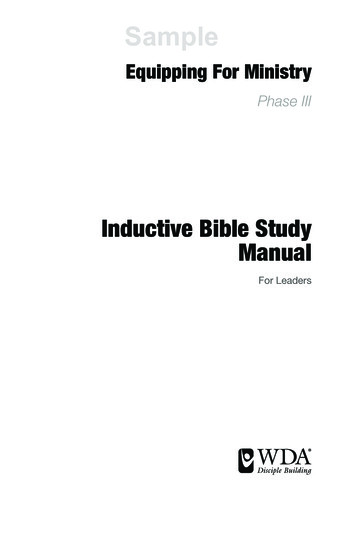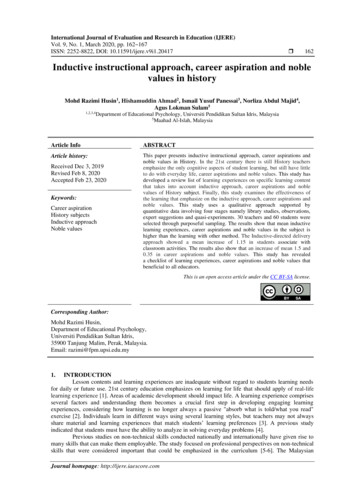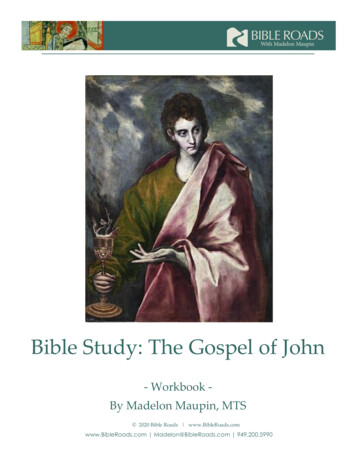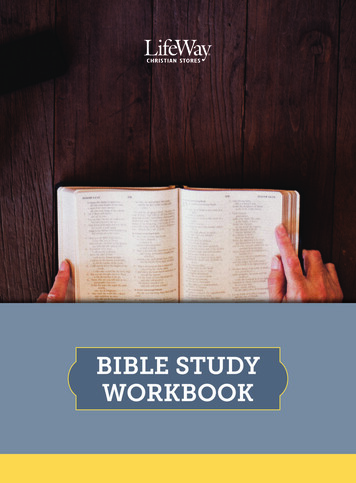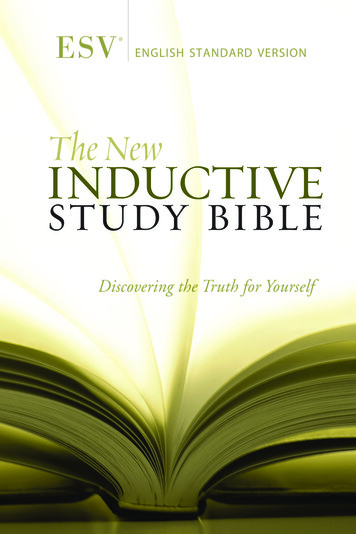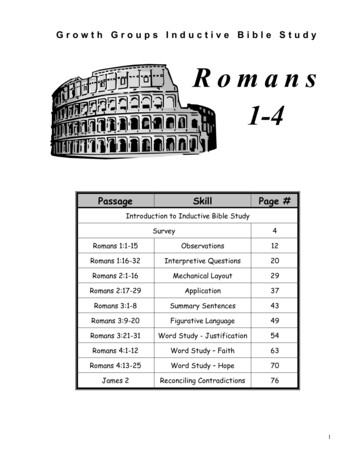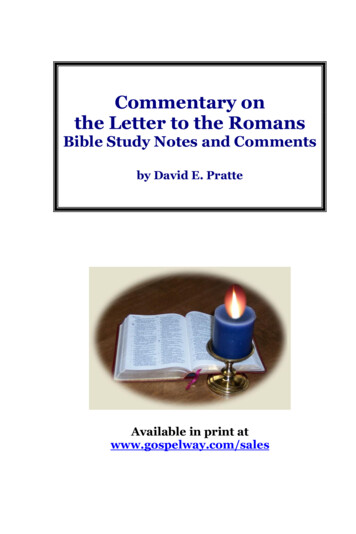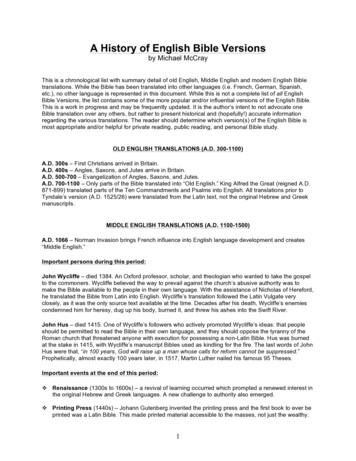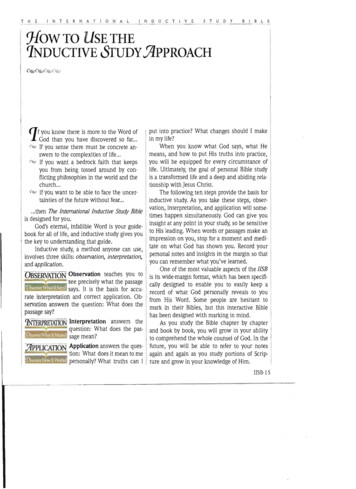
Transcription
THEI N T ERNA T IONA LINDUCT I V ESTUD YBIBLEg{OWTO USE THE7NDUCTIVE STUDY PPROACH(Jf you know there is more to the Word of-.I God than you have discovered so far.( If you sense there must be concrete an swers to the complexities of life.( . If you want a bedrock faith that keepsyou from being tossed around by con flicting philosophies in the world and thechurch.( If you want to be able to face the uncer tainties of the future without fear.then The International Inductive Study Bibleis designed for you.God's eternal, infallible Word is your guide book for all of life, and inductive study gives youthe key to understanding that guide.Inductive study, a method anyone can use,involves three skills: obselVation, interpretation,and application.OBSERVATION Observation teaches you to-.see precisely what the passagesays. It is the basis for accu rate interpretation and correct application. Ob servation answers the question: What does thepassage say?CZN'tERPREfATION Interpretation answers thequestion: What does the pas sage mean?(Discovcr' bat ILSays!371PPUCATION Application answers the ques tion: What does it mean to mepersonally? What truths can Iput into practice? What changes should I makein my life?When you know what God says, what Hemeans, and how to put His truths into practice,you will be equipped for every circumstance oflife. Ultimately, the goal of personal Bible studyis a transformed life and a deep and abiding rela tionship with Jesus Christ.The following ten steps provide the basis forinductive study. As you take these steps, obser vation, interpretation, and application will some times happen simultaneously. God can give youinsight at any point in your study, so be sensitiveto His leading. When words or passages make animpression on you, stop for a moment and medi tate on what God has shown you. Record yourpersonal notes and insights in the margin so thatyou can remember what you've learned.One of the most valuable aspects of the IISBis its wide-margin format, which has been specifi cally designed to enable you to easily keep arecord of what God personally reveals to youfrom His Word. Some people are hesitant tomark in their Bibles, but this interactive Biblehas been designed with marking in mind.As you study the Bible chapter by chapterand book by book, you will grow in your abilityto comprehend the whole counsel of God. In thefuture, you will be able to refer to your notesagain and again as you study portions of Scrip ture and grow in your knowledge of Him.IISB-IS
THEI NTERNATIONALINDUC TIVESTUDYBIBLEOBSERVATION.o O N-E----------STEPBEGIN WITH PRAYERPrayer is often the missing element in Biblestudy. You are about to learn the most effectivemethod of Bible study there is. Yet apart fromthe work of the Holy Spirit, that's all it will be a method. It is the indwelling Holy Spirit whoguides us into all truth, who takes the things ofGod and reveals them to us. Always ask God toteach you as you open the Scriptures.u STEPTw--o--------- ASK THE" 5 W'S AND AN H"As you study any passage of Scripture, anybook of the Bible, train yourself to constantlyask: Who? What? When? Where? W ? How?These questions are the building blocks of pre cise observation, which is essential for accurateinterpretation. Many times Scripture is misinter preted because the context isn't carefully ob served.When we rush into interpretation withoutlaying the vital foundation of observation, ourunderstanding becomes colored by our presup positions-what we think, what we feel, orwhat other people have said. We must be carefulnot to distort the Scriptures to our own destruc tion (2 Peter 3: 16).Accurate answers to the following questionswill help assure correct interpretation.Who is speaking? Who is this about? Whoare the main characters? For example, look at thesample passage from 1 Peter 5 (see page IISB-19).In this chapter, "I" is speaking. Verse 1 tells usthat "I" is a fellow elder, a witness of the suffer ings of Christ, and a partaker of the glory to fol low. From reading this and previous chapters(the context), you recognize that the "I" is Peter,the author of this epistle.And, to Whom is he speaking? Verse 1refers to "the elders," verse 5 to "you youngermen," and verse 6 to "yourselves" (the recipientsof the epistle).What is the subject or event covered in thechapter? What do you learn about the people,the even or the teaching from the text? Whatinstructions are given? In 1 Peter 5:2, Peter in structs the elders to shepherd the flock andexercise oversight.When do or will the events occur? Whendid or will something happen to a particular per son, people, or nation? When is a key questionin determining the progression of events. In1 Peter 5:4, we learn that "when the Chief Shep herd appears," the elders will receive their "unfad ing crown of glory."Where did or will this happen? Where wasit said? In 1 Peter 5, the only reference to aplace is in verse 13, where there is a greetingfrom "she who is in Babylon."Why is something being said or mentioned?Why would or will this happen? Why at thistime? Why this person? First Peter 5: 12 explainswhy and how Peter wrote this epistle, establish ing the book's purpose: to exhort and testify thatthis is the true grace of God, that they may standfirm in it.IISB-17
THEI N TERN ATI O NALI N DUCTIHow will it happen? How is it to be done?How is it illustrated? In I Peter 5:2, note howthe elders are to exercise oversight: voluntarilyand eagerly, according to the will of God.Every time you study a passage of the Bible,you should keep the "5 W's and an H" in mind.Don't be concerned if you can't find the answerto each question every time. Remember, thereare many types of literature in the Bible and notall the questions will apply. As you ask what,when, who, where, why, and how, make notesin the margin of your Bible. Meditate on thetruths God reveals to you. Think how they applyto you. This will keep your study from becom ing an intellectual pursuit of knowledge for itsown sake. -------- S T E- P TH R E E---------MARK KEY WORDSAND PHRASESAkey word is one that is essential to the text.It might be a noun, a descriptive word, or an ac tion that plays a part in conveying the author'smessage. A key word or phrase is one which,when removed, leaves the passage devoid of mean ing. Often key words and phrases are repeated inorder to convey the author's point or purpose forwriting. They may be repeated throughout achapter, a segment of a book, or the book as awhole. For example, notice that some form of theword suffering is used three times in I Peter 5.As you mark key words, ask the same Who,what, When, Where, why, and how questions ofthem as you did of the passage as a whole. Forexample, who suffers?, what caused the suffer ing?, etc.Key words can be marked in several ways: Through the use ofsymbols.L IISB-18V ES TUDYBIBLEThrough the use of colors. Colored pencilsand multicolored ballpoint pens with fine tipswork best.FAITHHUMILITYGRACE Through a combination of colors and sym bols.The value of a distinctive marking systemcannot be overestimated. Whichever system youchoose, mark each key word the same wayevery time you observe it. Then, in future study,the visual impact of your marks will help youtrack key subjects and quickly identify significanttruths throughout Scripture. To be sure that youare consistent, list key words, symbols, andcolor codes on an index card and use it as abookmark in your Bible.Be sure to mark pronouns (I, you, he, she,it, we, our, and so on) and synonyms (words thathave the same meaning in the context) the sameway you mark the words to which they refer.For example, a synonym for the devil in I Peter5:8 is "adversary." The pronoun "him" in verse9 also refers to the devil. Notice how markingthe synonym "adversary" for the devil gives addi tional insight into his nature. STEP PO-U -R-------- LOOK FOR LISTSMaking lists can be one of the most enlight ening things you do as you study a section ofSCripture. Lists reveal truths and highlightimportant concepts. The best way to discoverlists in the text is to observe how a key word isdescribed, note what is said about someone orsomething, or group related thoughts or instruc tions together. (You may want to develop yourlists on a worksheet before transferring them toyour Bible.)
'THE lJISB MARKING PPROACH1 PETER 5( SAMPLE AI DEVELOP CHAPTERITHEMESChapter 5 Theme'& Hum hie. Stiu,i Res'r.sf- S-tand r:irmthe5and CWitnessI exhortofaTherefore,2 shepherdathe Ckyou xercisingof God aIAAngoversight bnotcompulsio 3. ut voluntarU)t?according to the will of God; and for sordid gai 5 ut with eagerness;1713f.nor yet as alording it over lthose allotted to your charge;1but'----I nder4 And when the Chief aShepherd appears, you will receive the bun fading lccrown of glory.5and all offor dGOD IShand of God,7 casting all your aanxiety upon Him, because He cares for you.8 aBe of sober spirit, bbe on the alert. Your adversary, cthe devil,prowls about like a roaring dlion, seeking someone to devour.9 laBut resist him, bfirm in your faith, knowing that cthe same expe riences ofe . are being accomplished by your 2brethren whoare in the world.10 And after you have uffe Ii afor a little while, the bGod of allgrace, who ccalled you to His deternal glory in Christ, will Himselfeperfect, !confirm, strengthen and establish you.11 aTo Him be dominion forever and ever. Amen.12our faithful brother '(for so I regard him), bI! J/ youthat this is cthegrace of . dStand firm in it!'She who is in Babylon, chosenwith you, sends youand so does my son, aMark.aGreet one another with a kiss of' - --I bPeace be to you all who are in iSt.f99,.MAKE TOPICAl USTS,FROM K V WORDS COMPILE IN THE MARGINIISB-19
THEINTERNATIONALI N D U C TIVE1 Peter 5:2,3, for example, contains a simplelist instructing the elders how to shepherd theirflock. You can number simple lists within thetext for easy reference.Topical lists capture a truth, quality, or char acteristic of a specific subject throughout a pas sage. One way to discover a topical list is to fol low a key word through a chapter and notewhat the text says about the word each time it isused. See sample Afor how a list could be madefor the key word "suffering."As you write your observations on suffering,you will begin to have a better and broaderunderstanding of God's thoughts on this subject.You will learn that:C\\; Christ sufferedC\\. the brethren in the world are sufferingC\\. the recipients of the letter may alsoendure sufferingYou will also discover that God:(""\\; perfectsl""\\; strengthens( \,vconfirms establishes those who sufferThe application value of lists such as these isimmeasurable. The next time you endure suffer ing, you will be able to recall more quickly that:Christ sufferedothers are sufferingC\\. ultimately God will use suffering tostrengthen your own lifeDiscovering truths that apply to your dailylife is what makes lists such an important part ofthe inductive method.C\\. c\,\.,S TUD YBIBLEeasier to remember what you have learned.A contrast is a comparison of things that aredifferent or opposite, such as light/darkness orproud/ humble. The word "but" often signifiesthat a contrast is being made. Note contrasts inthe text or in the margin of your Bible.A comparison points out similarities and isoften indicated by the use of words such as"like," "as," and "as it were." For example, Petersays in 1 Peter 5:8: "Your adversary, the devil,prowls about like a roaring lion." Highlight com parisons in a distinctive way in the text so thatyou will recognize them immediately when youreturn to the passage in the future.ST E P-------0 1 - X:-:----- NOTE EXPRESSIONS OF TIMEThe relationship of events in time oftensheds light on the true meaning of the text. Thetiming of something can be observed in exactstatements such as "on the tenth day of theeleventh month" or "at the Feast of Booths."These phrases can be indicated in the marginby drawing a simple clock faceor a similarsymbol.Time is also indicated by words such asuntil, then, when, and after- These words showthe relationship of one statement or event toanother. Marking them will help you see thesequence of events and lead to accurate inter pretation of Scripture. . ----------ST-E P 0 E V-E-N----------IDENTIFY TERMS OF CONCLUSION .Q STEP I V-E---------Terms of conclusion usually follow an impor ------ tant sequence of thought and include words suchWATCH FOR CONTRASTSas wherefore, therefore, for this reason, andAND COMPARISONSfinally. As the saying goes, when you see aContrasts and comparisons use highly descrip "therefore" (or any term of conclusion), notetive language to drive home significant truths and what it is there for. You should be able to lookvital lessons. The word pictures they paint make it through the preceding verses and summarizeIISB-20
'THE fJISB MARKING PPROACH1 PETER 5( SAMPLEBMARK SYNONYMSIDENTIFY TERMSOF CONCLUSION.Rests - Smnd I1rmOPP()SED TO THEGIVES GRACE TO THElnUlIrlOLl' .hand Of "may exalt you at the prop rjime,7all your aanxiety upon , because ares for you.8 aBe of sober spirit b on the alert. Your adverse eVl , . .prowls about likearing dIio.one 0 evour.9 laBut resist him,.r faith, knowing that cthe same expeI' ,Irien.ces of suffering are being accomplished by your 2brethren who.I I m.'"LI@10the bGod of allgrace,will Himselfeperfect, iconfirm, strengthen and establish11 aTo Him be dominion forever and ever.12 Through aSilvanus, our faithful brotherNOTEhave written to you briefly, exhorting andEXPRESSIONStrue grace of God. dStand firm in it!' - - - - - - - - - - OF TIME13 IShe who is in Babylon, chosen together with you, sends yougreetings, and so does my son, aMark.14 aGreet one another with a kiss of love.bPeace be to you all who are in Christ.DISCOVERLESSONS FOR UFEIISB-21
THEINTERNATIONALINDUCTIVESTUDYBIBLEthe message. For example, 1 Peter 5:6 says,IotJX S T E P T E::-:N---::------- - "Humble yourselves, therefore . " If you willlook, you will discover that you should humbleyourself under the hand of God because God "is COMPLETE THE AT A GLANCE CHARTopposed to the proud, but gives grace to theThe AT A GLANCE chart, found at the endhumble."of every book in the IISB, provides a compactvisual surrunary of the book that you can return ----------S T E P-C IG H T -------to again and again for easy reference. See thesample AT AGLANCE charts on the followingDEVELOP CHAPTER THEMESpages.The theme of a chapter will center on the ( Record the author of the book. If themain person, event, teaching, or subject of that author is not mentioned by name, read the intro section of Scripture. Themes are often revealed duction for that book. If the author is not men by reviewing the key words and lists you devel tioned in either place, leave this space blank.oped. Try to express the theme as briefly as pos Record the date the book was written. Ifsible, using words found in the textthe date of writing is known, it will be mentioned-----Chapter 5 Theme'5 Hum hie. SrttrIaTherefore, I exhort the elders among you,and cwitness of the sufferings of Christ, anthe glory that is to be revealed,I2 she.pherd :the Jl k of God among you , exeFor example, possible themes for 1 Peter 5might be Exhortations to Elders, Younger Men,and the Suffering, or God Gives Grace to theHumble. The point of observation is to answerthe question: What does the passage say? Thetheme summarizes the answer. If needed, youcan adjust your themes as your study deepens.Id T E P WI- N-E S c---- DISCOVER LESSONS FOR LIFEIn the process of observing the text and see ing how God instructed people and dealt withvarious individuals, the Holy Spirit will bring toyour attention truths that God wants you to beaware of and live by in your own life. These"Lessons for Life" can be noted in the marginunder the abbreviation "LFL," or you may wishto create a distinctive symbol to mark yourLessons for Life throughout your IISB.in the introduction that precedes each book.C,,", Record the key words. If the key wordsare not already listed on the AT AGLANCE chart,you will find them listed in the THINGS TO DOsection at the beginning of each book.In order to notice subjects which runthroughout the entire Bible, there are some keywords or phrases you will want to consistentlymark in a distinctive manner. Write these on acard, color code them in the way you intend tomark them throughout your Bible, and use thecard as a bookmark.Some of the key words you will want tomark are listed below:sin (wickedness, evil, iniquity)covenantdeath (die)life (live)repentlovelawgracebelieve (faith)righteousness (righteous)holy (holiness)cry (cries, cried)BabylonIIS8-22r-- ------------------
'THE CJISB.7lT .7l gLANCE WARTS1 PETER SAMPLE C1Theme of 1 Peter: Cl;u(b;n PETER AT A GLANCEand er/0YLjSEGMENTDMSIONSAuthor:CH APTER THEMES k.rDate:12/rIalS fuv Ol1r' Fai.fh - 110( btir(. CJll flJ1: Follow (!Ju1 H;. a.mpJc--5uMnd---.J3 !,45.(, 3 or h4 1 .7).Purpose:10 C(11or' 1b efnNni" rue qmc!KeyWords':suffering(a nd all itssynonyms)graceglorysalvationJesus ChristGodHoly SpiritcaUedchosenholyIISB-23
THEINTERNATIONALINDUCTIVEnationsDay of the Lord (that day)Satan (any reference to the devil,spirits, demons, mediums)any reference to:Jesus' first comingJesus' second comingC'Q,.I Copy the chapter themes that you recordedat the beginning of each chapter. Because chap ter divisions were added much later than theBible was originally written, they do not alwaysfall naturally in the text. Occasionally you willfind a chapter with more than one theme. If thisis true, record both themesC\\. Look for and record segment divisions.See if any of the chapters can be grouped undera common theme or a common event. This iscalled a segment division. Segment divisions helpyou see the framework of a book.The number and types of segment divisionswill vary. A book might be divided according todates, geographical locations, reigns of kings,major characters or events, topics, or doctrines.When you gain a broad view of a bookthrough its segment divisions, it is easier tounderstand its content and purpose. The AT AGLANCE chart for the book of John (sample D)shows a number of ways this book could bedivided. For example, on the last line under"Segment Divisions," you will notice "Structureof Book." This shows you how John presents hismaterial to achieve his purpose for writing thisgospel.C\\. Record the purpose of the book.Discerning the author's purpose for writing andthen keeping this purpose in mind while youstudy the text will help you handle the Word ofGod accurately. Unless the author specificallyIISB-24STUDYBIBLEstates his purpose for writing, as in 1 Peter 5: 12and John 20:31, you will have to discover it byother means:1. Look for the main subjects covered inthe book. These can often be recog nized as you study the key repeatedwords.2. Watch for any problems that are ad dressed. It may be that the author's pur pose in writing was to deal with theseproblems.3. Note exhortations and warnings that aregiven. These may be the reason for thebook.4. Observe what the author did not coverin his writing. When you know whatthe author covered and what was leftunsaid, you are better able to narrowdown the real purpose of the book.Generally the instructions at the beginningof each book in your IISB will help you under stand how that book might be divided.Record the main theme of the book.Once you have listed the theme for each chap ter, evaluated the author's purpose for writing,and observed the content of the book chapter bychapter and segment by segment, you will beprepared to determine the theme of the book.What one statement best describes the book as awhole?C\\. Once you have completed the ten steps ofobservation, you are ready to move into inter pretation and application.
THE iJISB.JlT .Jl gLANCE QIARTSGOSPEL OF JOHN "'" SAMPLE DJOHN AT A GLANCESEGMENT DMSIONS; "':J:, U V\ r. \It !;rt, "!riii';f \ lIf'"(j.' ,'4O?,t/')ffI:L C "h :.-§' .\' i nl5'""" R,"'"{! ,, l ofIRUfC«'uk,{ovL. IlJ1J f II.,vW dlhq dllt 3bom qain4WOm4J1 a:f5fitfhV/ 6bICQ4 I rcatin , 0007feAstI d(an n'j-ltmpIC-wall royo. loftiCl 189blind Wlanj dqmtn -btl ;t vt,lirejloldqeI ShtphUd10 http11t"AIS /AuiUS12dinner a. - (J.)tfhUl Y /Wltn! Stv{,f , W*,/(JfItJIGn1 on donluAfk.1 dotYllouWOf/(Su,nls18a.rrls-i- M1Q19UlH.if i')(lonZ20rl 5Urrccho()19 21do )t\-t lcve. M ?-l0F"r- W "" , n.s Irrrr'rac((. 17)' -c.5:",KeyWords: tthun4clG! ftu( f'-rthrtkoau.Hor:V mmal) I tru.:I11 sm Me.of16s0'dtTNl Ii tWldetT1tn Cfl risf-, {t;d /.s !int,md thus htVtFa#Jcrs hOU Ml1 htarfS hl hvubtc4OJ7iat ( vine. LI1 d bmncheS1-WI'f C;p;ri-l-/AAof'11u helper:;:;,. bt'WDIL Icliu!.fJta.t 3" r I f1K14v;:s Purpose:.ft1a. his rwi(fSecmmrmdlWll Is(') A.D. i5lAst Skppu I wa hln -thscip/ st:l 2 13-l If r- 0---;;:c; 00 m loquL-1hc Word /rohn-thl&phs -/ d.1Ii(J dtSap/ S " I a'[3'" ts: -;#-l [s '1i\i' ' t1 Oli\L,:fohnDate:\{" 'iX 'ct r;;, . CHAPTER THEMES3.1.;;r[ z 9'i ' .Author:"' [;, § 1'\!3Irr/ WMio.Jiws s1.I . ,.t;g'-;:s;:J.7"" S\1"",of . :: CIPLES.15frtci as}(.pttAyer / nI1 h - pr Pta yerm«-JIISB-25
THEINTER--TIVE- -N A TIO N AL - I- ND- UC-- -STUDYBIBLE RETATION1JiscoverWhat ItMeans!rwhile observation leads to an accurateunderstanding of what the Word ofGod says, interpretation goes a stepfurther and helps you understand what it means.When you accurately interpret the Word of God,you will be able to confidently put its truths intopractice in your daily life.Like many other people, you may have beentaught a system of belief before you ever studiedGod's Word for yourself. Or you may have formedopinions of what the Bible teaches before youcarefully examined the Scriptures. As you learnto handle God's Word accurately, you will be ableto discern if what you believe is in agreementwith Scripture. If this is your desire and youcome to the Word of God with a teachable spirit,God will lead you and guide you into all truth.As you seek to interpret the Bible accurately,the following guidelines will be helpful.1. Remember that context rules.The word context means "thatwhich goes with the text." To under stand the context you must be familiarwith the Word of God. If you lay thesolid foundation of observation, you willbe prepared to consider each verse inthe light of: the surrounding verses the book in which it is found the entire Word of GodAs you study, ask yourself: Is myinterpretation of a particular section ofScripture consistent with the theme,purpose, and structure of the boolz inwhich it is found? Is it consistent withother Scripture about the same subject,or is there a glaring difference? Am Iconsidering the historic and culturalcontext of what is being said? Nevertake a Scripture out of its context tomake it say what you want it to say.Discover what the author is saying;don't add to his meaning.2. Always seek the full counsel ofthe Word of God.When you know God's Word thor oughly, you will not accept a teachingsimply because someone has used oneor two isolated verses to support it.Those verses may have been taken outof context, or other important passagesmight have been overlooked or ignoredthat would have led to a different under standing. As you read the Bible regularlyand extensively, and as you becomemore familiar with the whole counsel ofGod's Word, you will be able to discernwhether a teaching is biblical or not.Saturate yourself in the Word ofGod; it is your safeguard against wrongdoctrine.3. Remember that Scripture willnever contradict Scripture.The best interpretation of Scriptureis Scripture. Remember, all Scripture isinspired by God; it is God-breathed.Therefore, Scripture will never contra dict itself.The Bible contains all the truth youwill ever need for any situation in life.IISB-27
THEI N TERNATIO NALSometimes, however, you may find itdifficult to reconcile two seemingly con tradictory truths taught in Scripture. Anexample of this would be the sovereigntyof God and the responsibility of man.When two or more truths that are clearlytaught in the Word seem to be in con flict, remember that we as humans havefinite minds. Don't take a teaching to anextreme that God doesn't. Simply hum ble your heart in faith and believe whatGod says, even if you can't fully under stand or reconcile it at the moment.4. Don't base your convictions onan obscure passage of Scripture.An obscure passage is one in whichthe meaning is not easily understood.Because these passages are difficult tounderstand even when proper princi ples of interpretation are used, theyshould not be used as a basis for estab lishing doctrine.S. Interpret Scripture literally.The Bible is not a book of mysti cism. God spoke to us that we mightknow truth. Therefore, take the Word ofGod at face value-in its natural, normalsense. Look first for the clear teaching ofScripture, not a hidden meaning. Under 1158-28INDUC TIVES TUDYBIBstand and recognize figures of speechand interpret them accordingly (seeBible Study Helps, page 2105).Consider what is being said in thelight of its literary style. For example,you will find more similes and meta phors in poetical and prophetic litera ture than in historical or biographicalbooks. Interpret portions of Scriptureaccording to their literary style.Some literary styles in the Bible are:C\\J Historical-ActsC\\J Prophetic-RevelationC\\J Biographical-LukeC\\.' Didactic (teaching)-RomansC\\.I Poetic-PsalmsC\\J Epistle (letter)-2 Timothy{ Proverbial-Proverbs6. Look for the single meaningof the passage.Always try to understand what theauthor had in mind when you interpreta portion of the Bible. Don't twist versesto support a meaning that is not clearlytaught. Unless the author of a particularbook indicates that there is anothermeaning to what he says, let the pas sage speak for itself.LE
THEINTERNATIONALINDUCTIVESTUDYBIBLE PPLICATION'No matter how much you know about wrongly or have not been doing what God saysGod's Word, if you don't apply whatyou learn, Scripture will never benefityour life. To be a hearer of the Word and not adoer is to deceive yourself (James 1:22-25). Thisis why application is so vital. Observation andinterpretation are the "hearing" of God's Word.With application, you will be transformed intoChrist's image. Application is the embracing ofthe truth, the "doing" of God's Word. It is thisprocess which allows God to work in your life.Second Timothy 3: 16, 17 says: "All Scriptureis inspired by God and profitable for teaching,for reproof, for correction, for training in right eousness, that the man of God may be adequate,equipped for every good work." Here is the keyto application: Apply Scripture in the light of itsteaching, reproof, correction, and instructionson life.Teaching (doctrine) is what the Word ofGod says on any particular subject. That teach ing, whatever the subject, is always true.Therefore, everything that God says in His Bibleabout any given subject is absolute truth.The first step in application is to find outwhat the Word of God says on any particularsubject through accurate observation and correctinterpretation of the text. Once you understandwhat the Word of God teaches, you are thenobligated before God to accept that truth and tolive by it. When you have adjusted any false con cepts or teaching you may have believed, andembraced the truth revealed in God's Word,then you have applied what you have learned.Reproof exposes areas in your thinking andbehavior that do not align with God's Word.Reproof is finding out where you have thoughtis right. The application of reproof is to accept itand agree with God, acknowledging where youare wrong in thought or in behavior. This is howyou are set free from unbelief, from sin.Correction is the next step in application,and often the most difficult. Many times we cansee what is wrong, but we are reluctant to takethe necessary steps to correct it. God has not leftyou without help or without answers in this stepof correcting what is wrong. Sometimes theanswers are difficult to find, but they are alwaysthere, and any child of God who wants to pleasehis or her Father will be shown by the Spirit ofGod how to do so.Many times correction comes by simplyconfessing and forsaking what is wrong. Othertimes, God gives very definite steps to take. Anexample of this is in Matthew 18:15-17, inwhich God tells us how to approach a brotherwhen he sins. When you apply correction toyour actions and attitudes, God will work in youto do His good pleasure (Philippians 2: 13). Joywill follow obedience.Training in righteousness: Although God'sWord is profitable for reproof and correction, theBible was also given to us as a handbook for liv ing. As we spend time studying His Word, Godequips us through:c ) teachings( commands promises( exhortations warningsC\'Y and the lives of biblical charactersand God's dealings with manIISB-29
THEINTER NATIONALINDUCTIV ES TUDYBIBLEScripture has everything you need to meet child? Are there any new truths to be believed?any and all situations of life, so that you "may be Are there any new commandments to be actedadequate, equipped for every good work." The upon? Are there any new insights I am to pur most effective application takes place as you go sue? Are there any promises 1am to embrace?4. When applying Scripture, beware ofbefore the Lord and talk with Him about thosethings that you have read, studied, seen, and the following:,\)., Applying cultural standards rather thanheard.biblical standardsINSIGHTS ON('Y Attempting to strengthen a legitimateAPPLYING SCRIPTUREtruth by using a Scripture incorrectly, , Applying Scripture out of prejudice fromIn applying Scripture to your life, the follow ing questions may be helpful:past training or teachingOne of the apostle Paul's concerns for1. What does the passage teach? Is itgeneral or specific? Does it apply only to specific Timothy, his son in the faith, was that Timothypeople
life. Ultimately, the goal of personal Bible study is a transformed life and a deep and abiding rela tionship with Jesus Christ. The following ten steps provide the basis for inductive study. As you take these steps, obser vation, interpretation, and application
